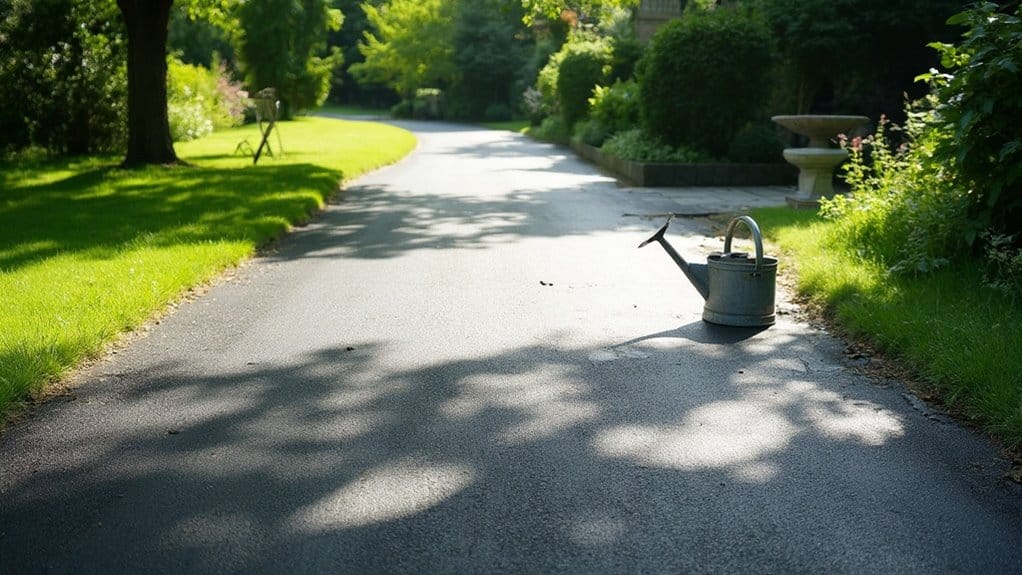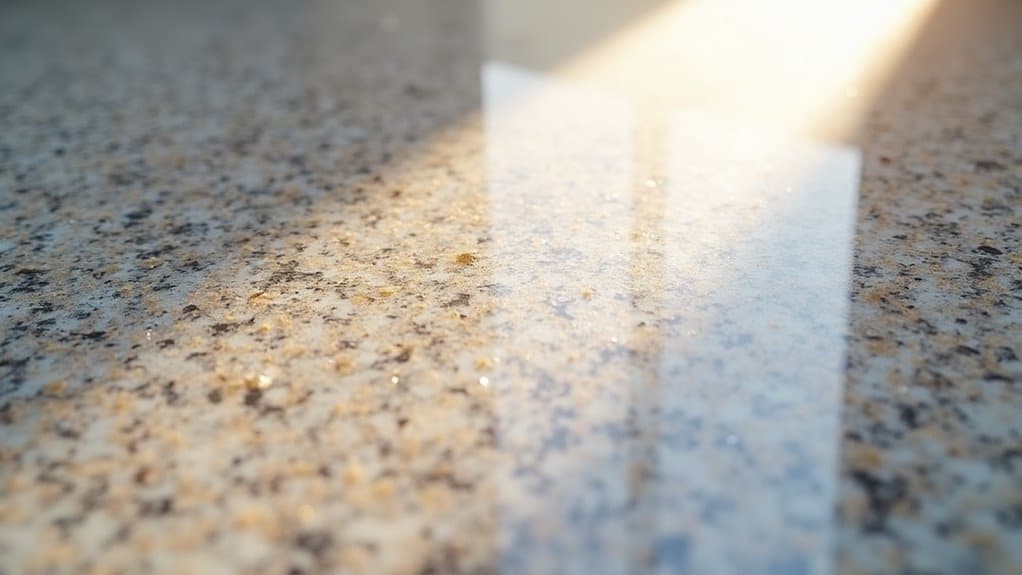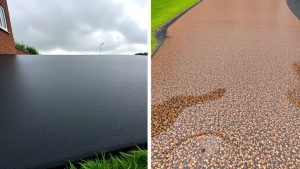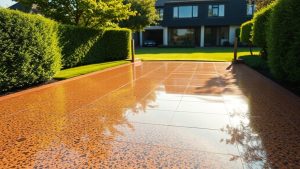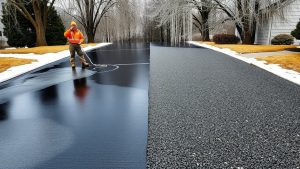To prolong the life of your tarmac driveway, establish a regular maintenance routine. Sweep away debris frequently and check for any cracks or stains. If you notice oil spills, tackle them immediately using absorbent materials and eco-friendly cleaners. Applying a sealant every 3-5 years will safeguard your driveway from UV damage and stains. Ensure proper drainage to avoid pooling and erosion. By following these steps, you’ll keep your driveway in good condition and enhance its appearance. Learn more about additional ways to boost your driveway’s longevity.
Table of Contents
ToggleKey Takeaways
- Regularly check for cracks and potholes, and fix them quickly to prevent further damage and ensure safety.
- Apply eco-friendly sealants every 3-5 years to shield against UV rays, weathering, and stains.
- Clean the surface regularly with mild, tarmac-specific cleaners to avoid stains and surface damage.
- Install channel or trench drains to ensure effective drainage, managing water runoff and preventing erosion.
- Steer clear of harsh chemicals and high-pressure washers, as they can damage the tarmac surface and shorten its lifespan.
Regular Maintenance Practices
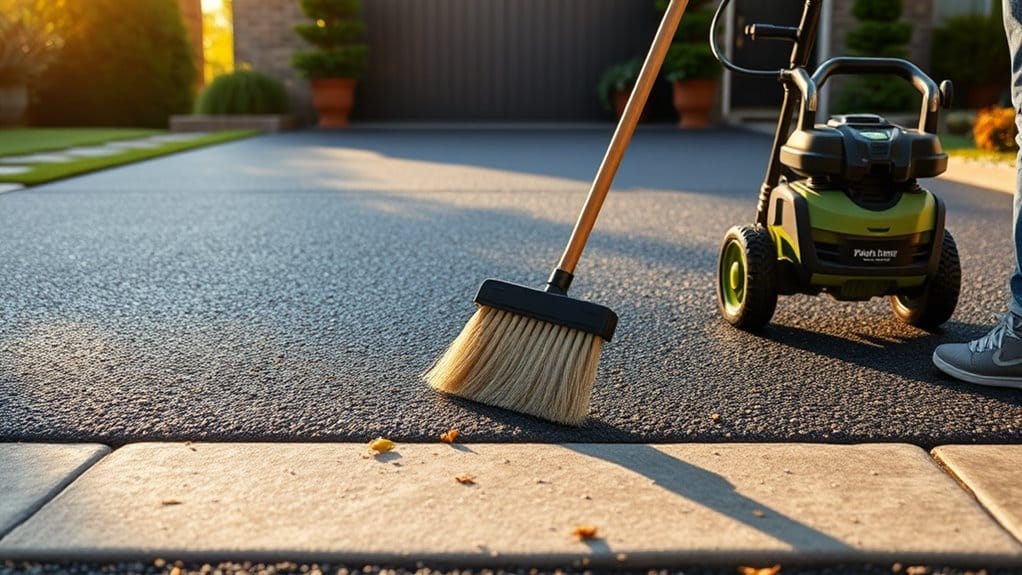
To prolong the life of your tarmac driveway, regular maintenance is essential. Start with simple tasks like sweeping or using a leaf blower to clear away loose dirt and debris. This helps prevent surface damage and improves the overall appearance. Use gentle, tarmac-specific cleaners to maintain the surface—stay clear of harsh chemicals and high-pressure washers. Implementing regular inspections can help you catch any issues before they escalate into more significant problems. Additionally, be mindful of temperature changes that can affect the integrity of your driveway.
Set up a maintenance schedule that includes rinsing with a garden hose to prevent water from pooling, which can cause cracks. Regularly inspect your driveway for any cracks or potholes and address them promptly. For minor issues, tarmac repair compounds work well, but for more significant damage, it’s best to consult professionals. Following these straightforward practices will help keep your driveway in excellent condition for years to come.
Protecting Against Stains
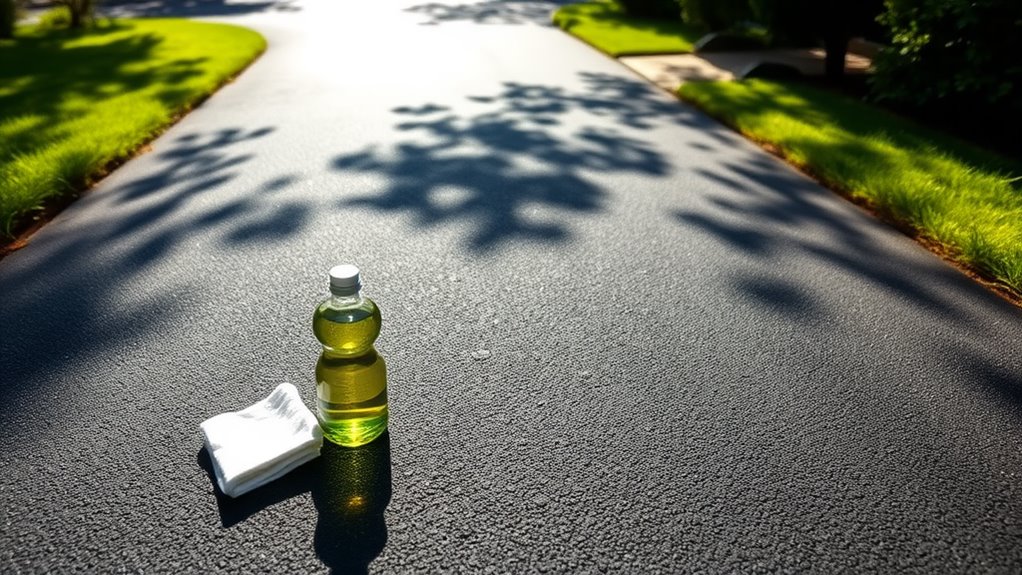
Maintaining your tarmac driveway involves more than just regular cleaning; protecting it from stains is crucial for its longevity. Stains from oil, organic matter, rust, and tyre marks can damage the surface if not dealt with promptly. To prevent staining, regularly apply sealants and manage drainage to reduce debris build-up. For fresh oil spills, use absorbent materials like cat litter to stop the oil from soaking in. When stains do occur, use appropriate cleaning methods: apply degreasers for oil, a vinegar solution for organic stains, and lemon juice for rust. Tarmac driveways are also prone to tire marks, which can be particularly problematic in hot weather. Regular inspections can help identify any common issues early on. Always test any cleaning solution on a small, hidden area first. By taking these preventive measures and acting quickly on stains, you can significantly extend the life of your tarmac driveway.
Timely Repairs for Cracks and Potholes
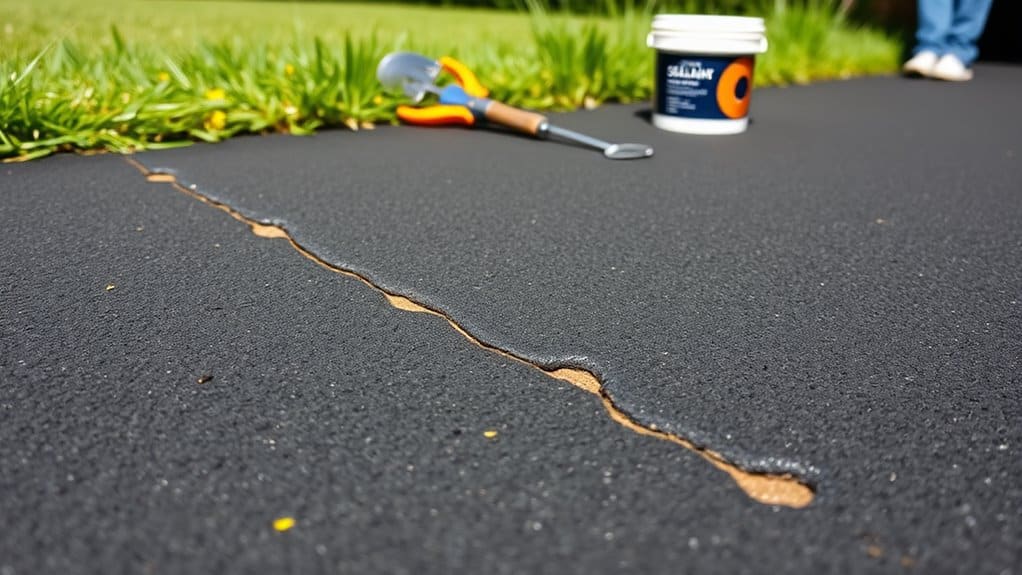
Timely repairs for cracks and potholes are vital for keeping your tarmac driveway in good condition. Using the right repair materials ensures a long-lasting fix. Regular checks can help identify issues before they worsen, ultimately prolonging your driveway’s life. For instance, a small crack, if left untreated, can turn into a larger problem, leading to costly repairs down the line. Addressing these matters promptly is key to maintaining your driveway’s integrity. Regular maintenance such as resurfacing or sealing every 3-5 years can also significantly enhance the durability of your driveway. Additionally, proper sub-base preparation is crucial for ensuring that repairs are effective and long-lasting.
Importance of Prompt Repairs
While minor cracks and potholes might seem trivial at first, addressing them promptly is crucial to preventing more serious damage to your tarmac driveway.
Ignoring these issues can lead to urgent repairs down the line, resulting in higher costs.
Here are three reasons to prioritise timely repairs:
- Prevent Escalation: Small cracks can widen under heavy traffic, leading to more extensive repairs or even a full replacement.
- Maintain Safety: Potholes can cause damage to vehicles and create hazards for pedestrians and cyclists.
- Protect Property Value: A well-maintained driveway boosts curb appeal, positively influencing your property’s value.
Suitable Repair Materials
When repairing cracks and potholes in your tarmac driveway, selecting the right materials is crucial for lasting results.
For small cracks, use a crack filler to stop further damage. For deeper holes, cold-lay tarmac works well; simply overfill and compact it with a roller or tamper.
Tarmac patching compounds can help create a smooth, even surface, while tarmac sealers protect against weather damage and improve durability.
Consider robust options like FASTPATCH DPR, which cures quickly and includes recycled materials.
Use proper techniques, like smoothing with a trowel, to ensure strong, lasting repairs.
Always opt for quality materials to keep your driveway in good condition.
Regular Inspections Needed
Regular inspections are crucial for keeping your tarmac driveway in good condition.
They help you catch minor problems before they turn into major headaches.
It’s a good idea to carry out these checks every season for the best results:
- Spot Early Issues: Look for cracks and drainage problems before they get worse.
- Save Money on Repairs: Fixing small issues quickly can prevent costly repairs down the line.
- Protect Your Driveway: Sealing cracks stops water from getting in and damaging the foundation.
Seasonal Care Techniques
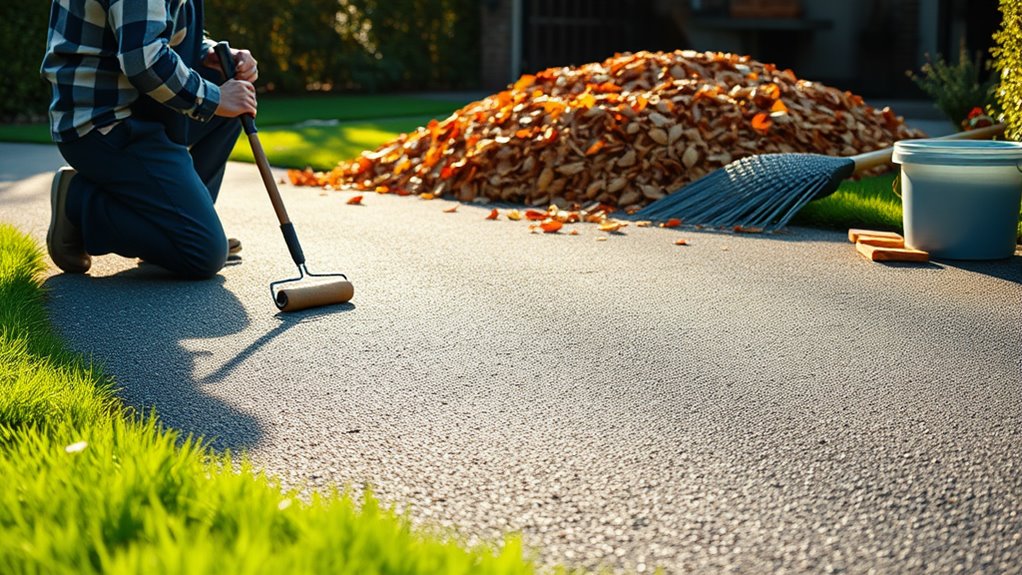
To keep your tarmac driveway in top condition all year round, it’s important to adopt seasonal care techniques that suit the UK climate.
In spring, start by clearing away any debris, treating for weeds, and checking for any damage from winter. This is also the time to apply a sealant for UV protection.
During the summer months, reduce wear by alternating your parking spots, using shade to help cool the surface, and pressure washing the driveway every 3-6 months to keep it clean.
In autumn, be diligent about managing fallen leaves and sealing any cracks to prevent moisture from getting in.
Winter calls for avoiding salt for de-icing, as it can damage the tarmac. Make sure there’s proper drainage to prevent ice formation.
It’s wise to inspect your driveway every 3-6 months, deal with any oil stains quickly, and apply sealants annually.
Effective Tarmac Protection Strategies
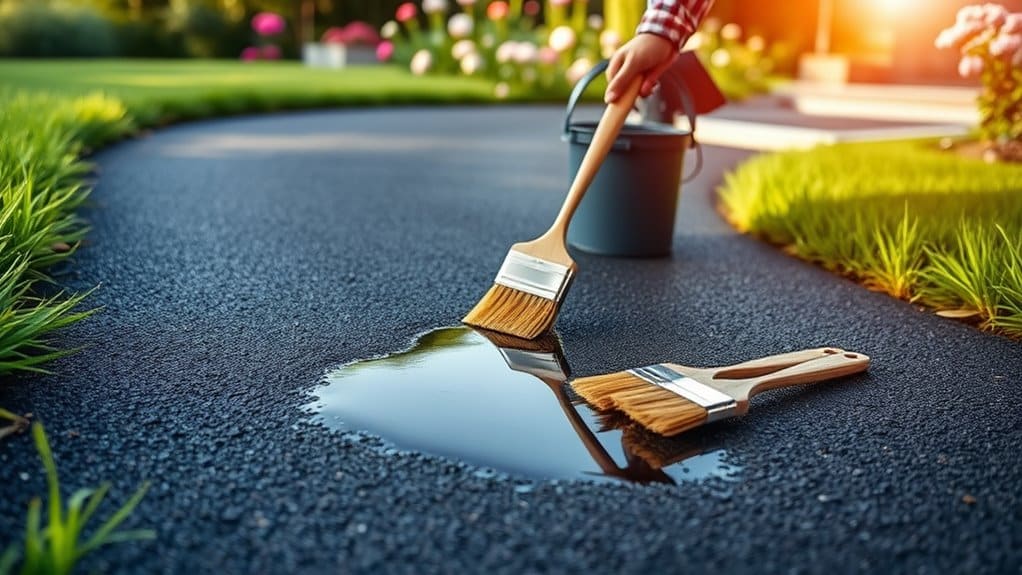
Effective tarmac protection strategies are vital for keeping your driveway in good shape and looking its best.
Here are some straightforward methods to extend the life of your tarmac and avoid expensive repairs:
1. Regular Cleaning: Regularly sweep or blow away leaves and debris to prevent staining.
Use a mild cleaner specifically made for tarmac to avoid causing any damage.
2. Crack Repairs: Check your driveway for cracks and fill them in promptly.
This helps prevent water from causing further damage and avoids structural problems down the line.
3. Protective Sealants: Consider applying a sealant to protect your tarmac from UV rays and weathering.
This will help it stand up better against the elements.
Initial Installation Considerations for Longevity
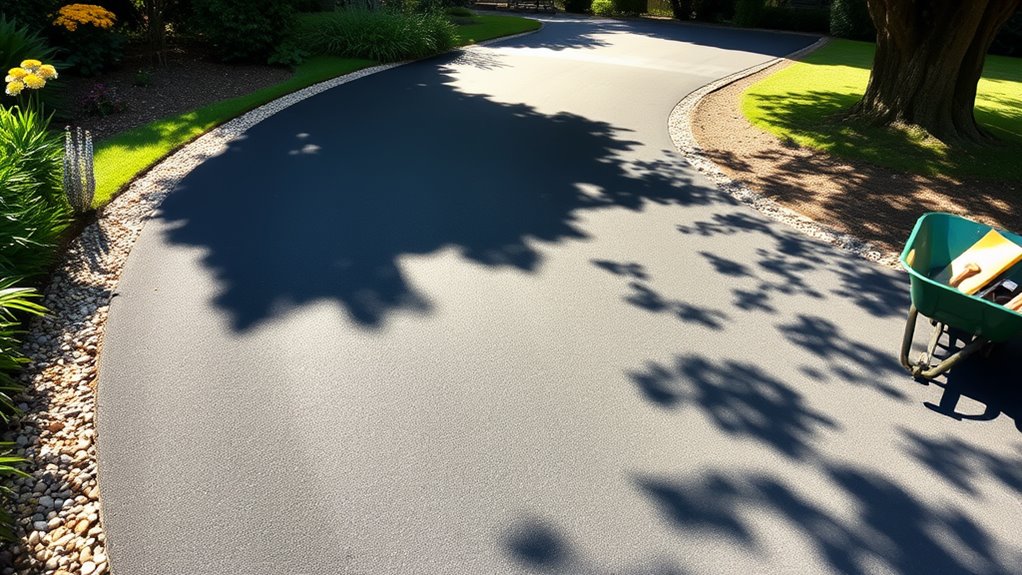
When planning your tarmac driveway installation, it’s crucial to consider a few key factors that can significantly influence its longevity. These include material selection and base preparation. Opting for high-quality aggregates and the appropriate type of bitumen will boost durability and weather resistance. Moreover, ensuring a properly prepared base is vital.
| Factor | Importance | Recommendations |
|---|---|---|
| Material Selection | Influences durability and resistance | Use top-grade aggregates |
| Base Preparation | Prevents settling and damage | Ensure proper compaction |
| Grading and Slope | Directs water runoff | Maintain a slight gradient |
Importance of Eco-Friendly Cleaning
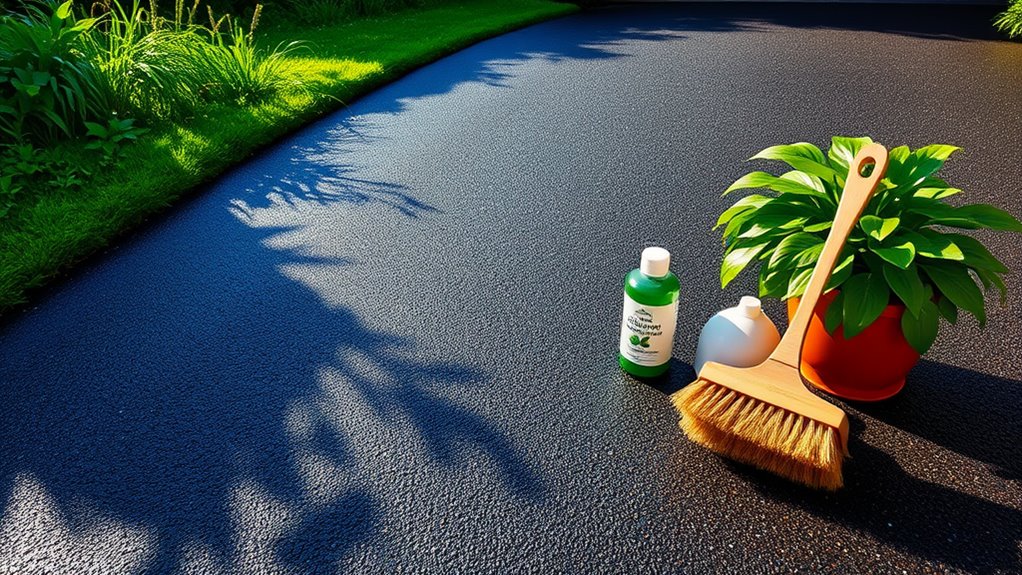
Choosing eco-friendly cleaning methods significantly reduces environmental impact by minimising chemical runoff.
These gentle cleaners not only protect your tarmac surface but also keep pets and plants safe.
Environmental Impact Considerations
While tarmac driveways are known for their durability and visual appeal, their environmental impact shouldn’t be ignored.
Adopting eco-friendly cleaning methods is crucial for sustainable upkeep. Here are three simple tips to keep your driveway clean while being kind to the planet:
- Mix vinegar and water to tackle organic stains like moss and algae.
- Choose biodegradable cleaners rather than harsh chemicals that could harm local plants and wildlife.
- Use natural ingredients like lemon juice or essential oils for regular cleans to maintain both appearance and integrity.
Surface Integrity Maintenance
Maintaining the surface integrity of your tarmac driveway is crucial for its durability and visual appeal, particularly as it faces various environmental challenges.
Start by managing debris; regularly sweep away dirt and loose materials to keep the surface tidy. While cleaning, check for cracks and stains, using eco-friendly solutions like vinegar or a mix of laundry soap for spot treatments.
Steer clear of harsh chemicals like bleach, as they can damage the tarmac. If you’re pressure washing, ensure the area is clear and use the correct pressure settings to avoid harm.
Promptly tackle stains and seal any cracks to prevent water infiltration. These simple practices not only improve the appearance but also extend the lifespan of your driveway, promoting environmentally friendly upkeep.
Health and Safety Benefits
Maintaining your tarmac driveway not only improves its look but also has important health and safety benefits. By opting for eco-friendly cleaning products, you reduce chemical exposure, making it safer for your family and pets.
Here are three main benefits:
- Chemical Safety: Eco-friendly cleaners lower the chance of harmful residues, creating a healthier environment at home.
- Vegetation Protection: These products prevent toxic runoff, protecting nearby plants and wildlife.
- Pollution Prevention: Biodegradable products help reduce water pollution, contributing to healthier ecosystems.
Using eco-friendly materials in your maintenance routine not only keeps your driveway in good shape but also supports sustainable practices for a safer, healthier home.
Addressing Oil Spills and Chemical Spillage
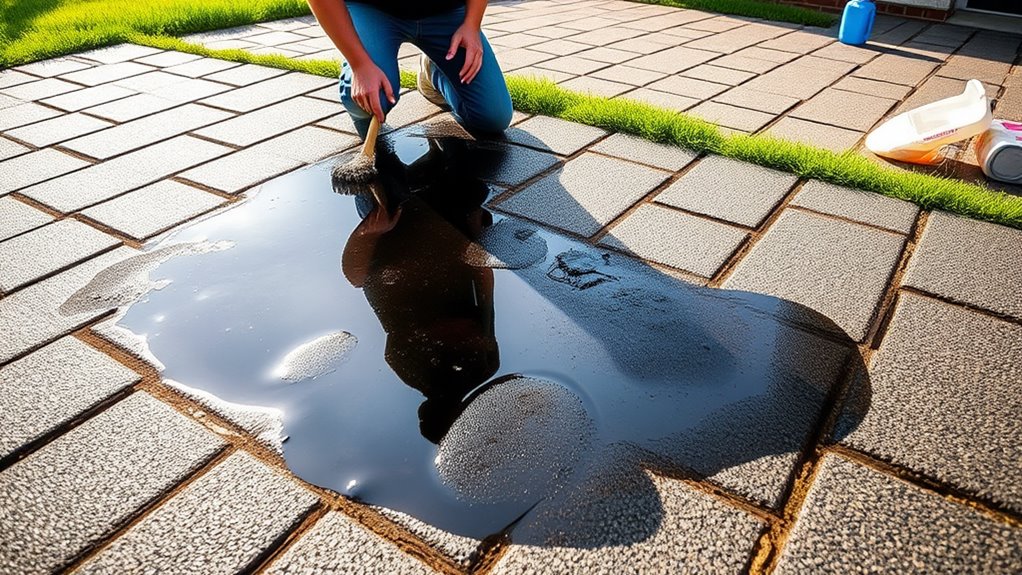
When an oil spill occurs on your tarmac driveway, acting quickly is crucial to prevent lasting damage.
Start by using absorbent materials like cat litter, sand, or baking soda to soak up fresh spills. For larger spills, you may want to hire professional cleaners to ensure thorough removal and reduce environmental risks.
Regular vehicle maintenance and using drip trays can help prevent oil leaks in the first place. For tougher stains, scrub with dish soap or use a specialised degreaser.
Always wear protective gear to avoid inhaling fumes or skin contact.
Enhancing Durability Through Proper Drainage
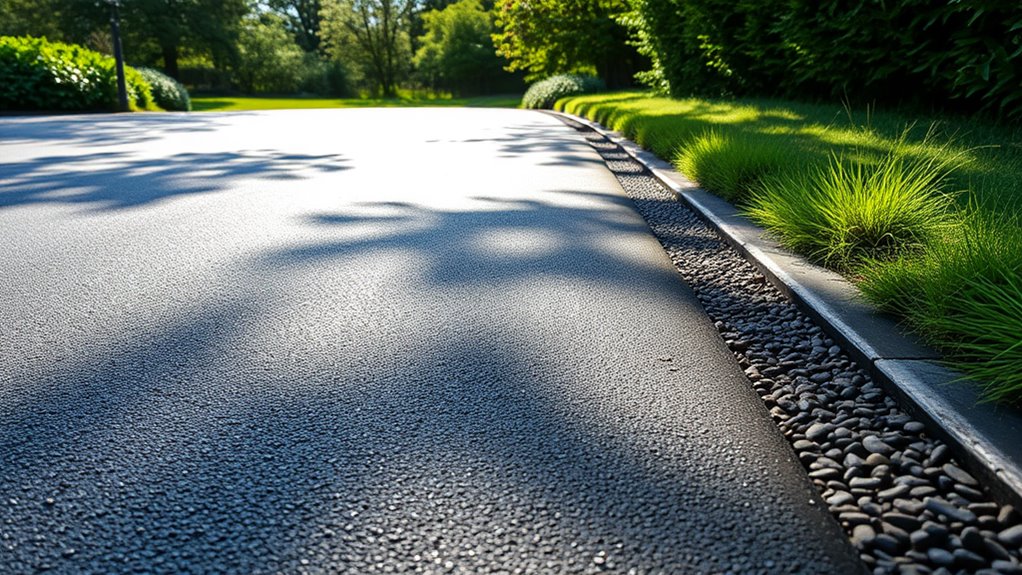
Effective drainage is crucial for improving the durability of your tarmac driveway, as poor water management can cause significant erosion and damage to the surface.
To ensure your driveway remains stable and to avoid expensive repairs, consider these drainage solutions:
- Channel Drains: Perfect for managing surface water efficiently.
- Trench Drains: Best for redirecting larger volumes of water across your driveway.
- Soakaways: Useful for managing runoff and preventing water from pooling underneath the pavement.
Frequently Asked Questions
How Often Should I Seal My Tarmac Driveway?
You should seal your tarmac driveway every 2 to 3 years, depending on the amount of traffic and local weather conditions. For instance, if your driveway sees heavy use or is exposed to harsh weather, you might need to seal it more frequently. Regular sealing helps protect your investment and extends the lifespan of your driveway.
Can I Drive on Freshly Repaired Areas Immediately?
You shouldn’t drive on freshly repaired tarmac straight away. It’s best to wait about 5-10 days for the tarmac to cure properly. Driving on it too soon can damage the surface and affect the repair’s durability. Think of it like letting a cake cool before slicing; rushing it can ruin the results.
What Weather Conditions Affect Tarmac Installation?
When laying tarmac, it’s crucial to consider temperature extremes and moisture levels. The best conditions are moderate temperatures with low humidity. For instance, avoid laying tarmac during a heatwave or heavy rain, as these can affect curing and reduce durability. Always plan your installation carefully to ensure optimal results.
Is It Safe to Use Pressure Washers on Tarmac?
Using a pressure washer on tarmac can be safe if you follow the right guidelines. Keep a safe distance from the surface and use the correct pressure settings to prevent damage. For instance, a low pressure is generally advisable—around 1000 to 1500 PSI—when cleaning tarmac. Always test a small area first to ensure you don’t strip the surface. Overall, with the right approach, you can effectively clean your tarmac without any issues.
How Do I Choose the Right Tarmac Contractor?
When selecting a tarmac contractor, it’s essential to evaluate their qualifications and read reviews. Look for contractors with established experience, appropriate licensing, and positive feedback from past clients. For instance, if a contractor has completed numerous successful driveways in your area, that’s a good sign they can deliver quality results. Ensuring you choose a skilled professional will help guarantee a job well done.
Conclusion
In summary, by following these maintenance tips, you’re not just extending the life of your tarmac driveway; you’re also boosting your property’s value. A bit of effort now can save you from expensive repairs later. Regular upkeep, prompt fixes, and protective measures will keep your driveway looking great for years. Plus, a well-maintained driveway improves curb appeal and saves you money in the long run.
Prepare the perfect base for your resin bound stone installation and discover the crucial factors that ensure lasting durability.
Know where resin bound surfacing can transform spaces for both residential and commercial use, and discover the countless benefits that Read more
A stone carpet combines beauty and resilience in flooring, but what makes quartz floors uniquely beneficial? Discover the secrets behind Read more

